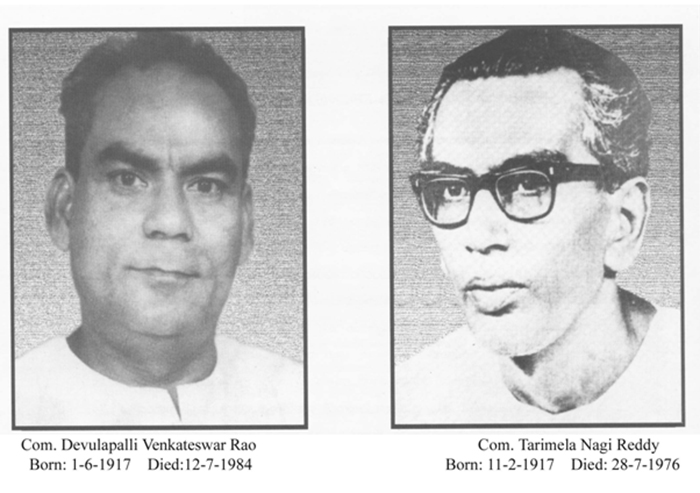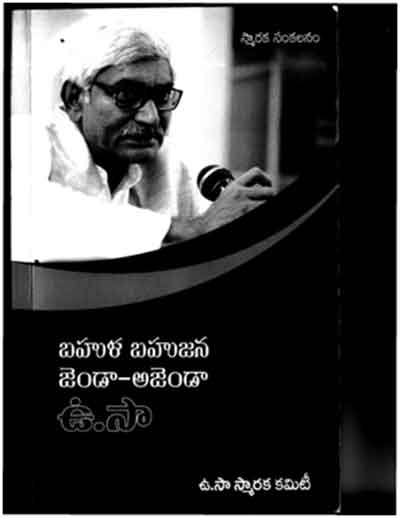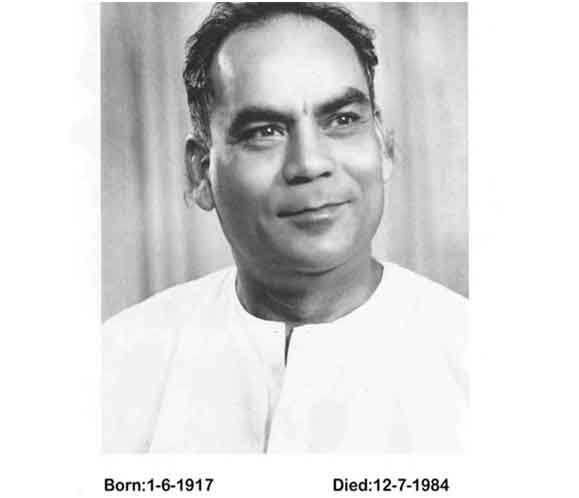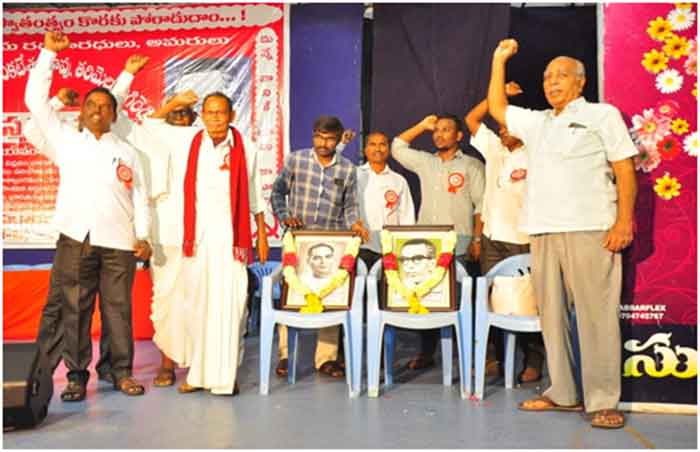
This is with reference to the article,“Can Brahmins Bring Revolution: An Assessment Through The Prism Of Tarimela Nagi Reddy” by Kancha Ilaiah Shepherd — CC, August 18, 2020.
I am not a writer. Not a leader or political activist. I am above my sixties, an ordinary citizen who earnestly wants that my country and society should be more democratic and egalitarian so that life of people is more prosperous and peaceful. I do participate, as per my capacity, in the social activities for this purpose. I have grown up reading and knowing something about the glorious history of the revolutionary movements of my land and hold highest regard and respect for the persons and personalities who participated in such movements which brought many favourable progressive changes in society.
I am pained much by some recent articles published (including countercurrents) and circulated after the tragic death of Mr.U Sa. Different ideologies prevail in society and one follows a certain path as per his conviction. Here I am not going into the discussion whether brahmins can bring revolution or which is the correct path. I am not suggesting that there is no Brahminical dominance in the society. I scribble a few points with a conviction that Persons, more so the ideologues or leaders of a certain path need not stoop down to such a low level as Prof.Ilaiah did in his two essays.
Mr. Ilaiah says he makes an “Assessment Through The Prism Of” TN.
I begin with one simple example how careless Ilaiah is with his facts, and on that basis he indulges in cooking up his theories. He wrote:
“Nagi Reddy as student Union President (in Varanasi BHU) has shaken the British administration and wrote a brilliant monograph for his M.A course on economic ideas of Muhammad Bin Tughluq, who was being portrayed as a mad man by the whole range of nationalist leaders, including the communist Brahmins like P.C.Joshi, Dange, Ranadive and so on…. So far none of these so-called Nagi Reddy followers published that monograph.”
The note on Tughlak was not prepared by TN for his M.A. exam. in Banaras university. It was done in Chennai Loyola college days of Intermediate (plus two) study This TN himself narrated in an interview which was published, not once but so many times, in journals as well as booklets, not only in telugu, but also in English hailed so much by Mr. Ilaiah.
How and why Ilaiah misses this simple fact and misrepresents it?
He uses it to theorise and assert:
“The Brahminical economists did not change their mad Tughluq narrative…” And drags in the BHU-VC, “conservative Brahmin Vedantic philosopher Sarvepally Radhakrishnan”! He blames “communist Brahmins “and then he goes to the extent of ascribing motives that the “monograph” was not published by the followers?
Was Nagireddy so weak a leader that his paper is not published? If really the said paper was important for him or for the present situation, he himself was in a position to publish and propagate it. He was the editor and printer of the journal Janashakti, until he died. Then why he did not do it? I feel leaders like TN and DV were not interested in personal publicity or motives but acted as per the needs of movement and revolution. It is well known that DV very rarely addressed public meetings, and TN was in to that job, very busy with it and was popular too.
M.A. Krishna in his article, How Not To Write Obituaries: Kancha Ilaiah Sets A Negative Example, brought out many falsehoods, and unethical things like usurping Usa’s book ‘Annihilation of Caste – A Marxist Approach 1989, as his own. Instead of answering those points, he indulges in another diversionary game and writes an article that is more of mud-slinging than a genuine theory. Such examples as of Tughlaq are plenty in his writings, including the present article, and were indeed pointed out time and again in Telugu media.
If this is the methodology he follows and indulges in cooking up his theories recklessly, how can he expect to be taken seriously?
It is not an “Assessment Through The Prism Of” TN, as claimed by Ilaiah, but through a prism of casteism.
Mr.Ilaiah resorted to character assassination of towering personalities like Devulapalli Venkateswara rao and Tarimela Nagireddy. A sinister attempt is made by Ilaiah now in the name of caste discrimination and a non-existing, artificial, baseless cleavage was sought to be created between them and promoted with ulterior motives. It appears as if an unnecessary discussion of deciding who is more worthy between the two leaders is proposed with malicious intention to suit their present caste politics. Telugu society is exposed to debates on class and caste for decades now. This is the first time their names are dragged into such a discussion. It was never done earlier by SC, ST, BC or any other section. Even Ilaiah did not name in this way earlier, as far as I know.
The progressive Telugu people treat Com DV and TN with utmost respect, as an inseparable duo in the revolutionary path and consider as the architects of the path of Indian revolution people never indulged in the frivolous discussion of who is number one or two. Even today people remember them as a single entity and hold meetings across AP and TS annually commemorating them from a single platform. Jwalamukhi (1938-2008 ) a Telugu revolutionary poet, known across India, described them popularly as Krishna (DV) and Arjuna (TN) who have their specific roles in mahabharatha; Tens of thousands of people who heard this largely cheered at this attitude.
It is natural to have some minor differences of opinion on the details of dealing or day to day implementation of few things, between any two leaders, in any party or organization. That is why committees hold discussions and decide by vote also if needed. Com DV and TN in their long association are known to have endorsed each other and in fact complemented each other and worked together. They walked the revolutionary path hand in hand supplementing each other. Never was a ray of discrimination seen in their relations. The recommendation Com.TN made to all revolutionaries, just few days before his death, to study the documents written by DV is an ample index of the cordial, comradely relations they had; TN’s views to this effect were published long ago, and reprinted as booklets.
Mr. Ilaiah vehemently asserts that DV was promoted to central committee of the then communist party and other posts as he was brahmin even though he was not worthy, whereas Nagi reddy was side-lined as he was a sudra in spite of his intellectual superiority. The fact is Nagi reddy was always in a respectable position, one time as Member of Loksabha (1957-62) and three terms as Member of Legislative Assembly, He was the floor leader, the youngest in such a post, in 1952. That was in the beginning days of the parliamentary path. Ever since the revolutionary path was revived post-1968 period, TN was always at the helm of the party, first as the Convenor of APCCCR, and then on as co- founder of UCCRI(ML) and always in the central committee.
Though DV was elected (in UCCRI-ML Founding Conference 1975) as secretary, in the context of splits into different groups, the Andhra revolutionaries were popularly called as “TN Party” throughout the country. In fact the leaders preferred to be identified as Andhra revolutionaries. Curiously 5-6 years later to his death, the very name of TN was sought to be utilised for their advantage, by a splinter group of UCCRI-ML, that faction very soon dropped the name of UCCRI. This is an ample evidence of the importance TN in the revolutionary camp.
Nobody till now saw that there was discrimination against him on the basis that he was sudra. In fact, in post-1947 Andhra politics, the very nomenclature of sudras was not used by anyone or media, (except Ilaiah now) Here they are spoken as upper castes, BCs, SCs, STs, and so on. and called as Reddys, Kammas, Velamas etc. They are regarded as so-called upper or dominant castes, both by their supporters and opponents, never labelling them as sudras.
Com. DV spent 17 years in underground activities as revolutionary and about 5 years in jails.TN also was in jails on several occasions totalling about 10 years and was in UG life for more than 5years. Almost every year we see these facts in newspaper articles with dates too. Both breathed their last in UG life, while steadfastly working for and directing the new democratic revolution of India, keeping themselves in UG, away from the eyes of the draconian State. The ruling class did not find any difference between a brahmin and sudra to arrest, harass or frame conspiracy cases against them. Persons of every caste were shot dead during and after Telangana struggle, in encounters as the lists reveal. Both the leaders were treated equally as a threat for the State and filed under Defence of India Act but a professor is splitting them now on caste basis!
The orthodox brahmin that DV was by birth, spent his communist life not in the shade as one of a rich, comfortable, Brahmin family but lived for years together in the houses of poor villagers, roamed in forests, mingled with dalits, adivasis and lambada people, eating and drinking what they offered, and facing the gunpoint of the rulers. Com. Ilamma (who now a days is highlighted as Chakali, washer woman, Ilamma) vividly explained once, how DV spent 15 days in her house eating whatever she has cooked or collected from the village houses. It may not be out of place to remind people that DV was instrumental in bringing her back into limelight, he met her again after decades in early 1980s, got her photographed and published, has re-focussed her as an inspiring revolutionary, in the inauguration of a Telugu literary magazine (Vadisela)in early 1980s (this writer attended that meeting). Her photo was published, for the first time in the History of Telangana by DV Rao.
Prof. Ilaiah says that DV being brahmin did not understand the productive forces and much intricate village level production relations. We have to just pity him, as the facts are quite contrary to his opinion. It is a well-known fact – not even his sworn enemy would contradict – that Com. DV was one leader who spent most of the time touring villages, organising them against atrocities of land lords, sensed the hunger of people for land, and made the land issue as number uno point in Telangana armed struggle. The police records too showed that.
Depending on the practical experiences in Telangana villages and the struggle to root out the feudal system, he has formulated the path of Indian revolution. It is not from his book knowledge but was from practice. Before any one did, he assimilated the essence of China’s line of agrarian revolution, understood the Russian insurrection and innovatively applied to concrete situation in India before his eyes. It was clear from a book, which he had written in 1949, re-published almost 40 years ago. I cannot find sufficient language to explain the crucial role played by him in the Telangana armed struggle.
May I remind that the case filed first time against him was regarding the land question, while he was engaged in activities to change radically the basic village structure itself. In essence it was this revolutionary contribution of recognising land issue as the axis of Indian revolution and chalking out the class relations in our society and his attempts to eradicate the unequal, semi-slavery relations in villages among the various sections of people, that made him the unique leader he was. Not without a reason or worth that he gained an exemplary position and it was definitely not due to his brahmin origin.
The persons seeing through the prism of caste have accused that all parties including the communists are led by only higher castes. This trend started in AP, mostly in 1980-90 period: they trumpeted about the “higher” caste of Chandra Rajeswara Rao (kamma) in CPI, P. Sundaraiah (Reddy) in CPM, Kondapalli Seetha Ramaiah (Reddy) in People’s War, Chandra Pulla Reddy (Reddy) in CPI(ML), and so on of various groups or parties. They were always called as “upper” castes in AP, and not called sudras. They accused that Dalits or BC caste people are left only to carry the flags and die for the sake of ‘high’ caste leaders. Now note that the leaders cited above are designated, by Ilaiah, as Sudras and are portrayed as victims of Brahmins, who in fact are no more in a dominant position political arena, more so in South India.
Mr. Ilaiah reduces everything into caste terms. I fail to understand how the professor judges the movements and the whole polity on basis of caste, but not principles and practice. After all, most reactionary and ruling class parties across India today are led by BCs, SCs and STs (Jharkhand etc). India with its communal and casteist politics today is led by a PM who called himself a BC. It often had minorities (muslim and sikh) and dalits as Presidents. Perhaps Ilaiah is happy with today’s India as various states being ruled by BCs and SCs and some by “Sudras”. Today’s India is seen by many as a fascist and Hindutva India. Does he not see it that way, because of his caste criteria? I am very sorry to pose such questions in terms of castes, but this is the level in which the professor Kancha Ilaiah shepherd has drawn his conclusions.
He also erroneously proposes that KG Satyamurthy did not get his due share as he was a dalit. On the other hand, Ilaiah says KGS (Siva sagar) was thought to be a Brahmin, going by his surname as a Murthy, till he exited from his party. He was its general secretary too (when KS was arrested). Then where is the question of caste descrimination? Does he not know there are many Kuru Murthys, Guru Murthys, Narayana Murthys etc who were non-Brahmins?
As a common man I think, highest popularity was gained by KGS as a poet and Gaddar as an artiste. And there are others like Vangapandu Prasada Rao (who died recently), Goreti Venkanna, Suddala Ashok Teja, who got maximium media coverage even though they are not brahmins. Despite bans, it is unique that Telugu media, electronic included, publishes literally hundreds of stories about them. It was because most of them were seen as representatives and harbingers of anti-landlord movements, and popular in the eyes of people. Would it have been possible in the absence of such movements? Even Varavara Rao fades out in popularity before them, including Shivasagar as a poet. May be VV is more popular as a spokesperson. Audiences in Telugu land never considered the caste of these persons but acclaimed them for their progressive work, and great artistic talent. Any one is at liberty to draw his own conclusions but the fact of the situation must not be distorted.
He also said that leaders proficient in English (he means brahmins) could dominate the field and sudra leaders were not proficient in ‘communist Sanskrit’ i.e., English. They felt inferior and that was the reason for remaining in back benches even in communist party. If English knowledge is the criteria for success then we fail to understand his argument- how a person like DV poor in English (as per Ilaiah) captured higher position and TN proficient in English could not achieve it. Is this not a self- contradictory proposition? His arguments are inconsistent and illogical: Most of the CMs in today’s India, more so in the North, are not proficient in English. Many persons proficient in English, Brahmin or otherwise, Communist or otherwise, cannot win an election based on their English. Even in bureaucracy, more so in North India, Hindi is given precedence, not English.
Mr. Ilaiah also accuses that defenders of DVR attacked him and are trying to establish that DV is intellectually superior to TN. As far as I know, DV defenders always consider Com. TN as their most valuable leader and mention so in all of their writings and activities and show the same respect to him as extended to DV. I attended many meetings, and can assert that. I have seen the same in articles published in countercurrets.org also.
As a reader I pointed out a few facts and expressed my views. My aim here is not to discuss the social philosophy of caste-based movements or to evaluate caste-class politics, which is not the scope of his article. This is only to bring out the blatant mis-representation aimed at confusing, and dividing the toiling masses, preventing them from the genuine democratic movements and instead to divert them playing up caste equations. Such an attitude ultimately stands with, supports and serves the rule of the present unequal, discriminative society. We have to save ourselves from the intellectual jargon of tearing the social fabric into tiny pieces. Quarrelling among ourselves and leaving safe the exploiting class, root cause of present miserable, is highly deplorable. More so in these days of rabid Hindutva and fascism. My response here is to caution against such consequences.
Suryaprakash is a political commentator
SIGN UP FOR COUNTERCURRENTS DAILY NEWSLETTER
















































